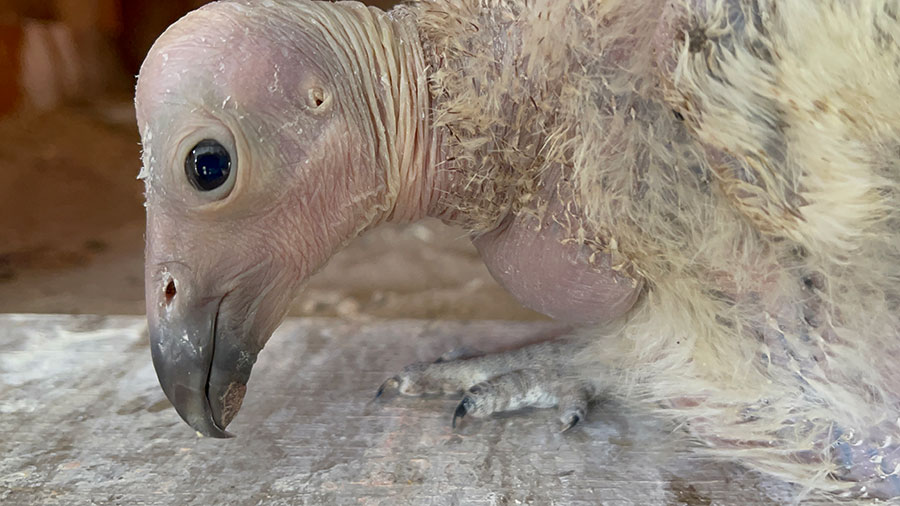Los Angeles Zoo Celebrates Successful Start of 2024 California Condor Breeding Season

LOS ANGELES, CA – April 8, 2024 — The Los Angeles Zoo welcomes its first FIVE California condor chicks of the 2024 breeding season. The first egg was laid at the Zoo at the beginning of January, marking an early start to the season. Since then, more have been laid for a total of 16 eggs so far this year. The first hatchling arrived March 1 and four more have already hatched in the past two weeks.
“Our condor pairs here are having a pretty epic egg laying season so far, and they are not done yet, ” said Mike Clark, Condor Keeper, Los Angeles Zoo. “We are seeing excellent fertility in the eggs produced so far, and we expect 4 to 5 more eggs before the 2024 laying season is over.”
The chicks are bred and reared at the Zoo as part of the California Condor Recovery Program administered by the U.S. Fish and Wildlife Service and partners across local, state, and federal agencies; indigenous tribes; and NGOs. All of the offspring bred at the Zoo are candidates for release into their native range.
The L.A. Zoo has housed California condors since 1967, when the now legendary Topa Topa came to the Zoo as a malnourished fledgling rescued in the wild. In 1983 there were only 22 California condors left on the planet, so the U.S. Fish and Wildlife Service and the California Fish and Game Commission agreed to create a captive breeding program for the species. Over the years, the Zoo’s role in this collaborative program has evolved from a focus on building a captive breeding population to one of monitoring and maintaining the populations of wild birds that have been re-established in California.
As of December 2023, there are 561 California condors in the world, of which 344 are living in the wild. The number fluctuates daily due to many outside influences such as habitat loss, pesticide contamination, consumption of micro trash in their environment, and above all, lead poisoning from eating lead bullet fragments or shot pellets found in animal carcasses. In recent years, the Highly Pathogenic Avian Influenza (HPAI) has become another growing threat to the survival of the species.
“The California Condor Recovery Program is a critical and highly successful component within the Zoo’s Conservation Strategic Plan,” said Dr. Jake Owens, Director of Conservation, Los Angeles Zoo. “As a conservation organization, we are not only focused on saving endangered wildlife in far-off habitats around the globe, but also species that are right here in our own backyard. The last thirty years has confirmed that by breeding and raising condors into adolescents here at the Los Angeles Zoo, we are giving them the best chance of survival after their release into the wild.”
The California condor is the largest land bird in North America with wings spanning an amazing nine-and-a-half feet! Adult condors stand at around three feet and weigh 17 to 25 pounds. The species can soar to heights of 15,000 feet and may travel up to 150 miles a day. Condors find their food mostly by their keen eyesight. Like vultures and other scavengers, condors are part of nature’s cleaning crew, feeding on the carcasses of large mammals including deer, cattle, and marine mammals such as whales and seals.
While California condors are not on exhibit at the Zoo, guests have the opportunity to catch a glimpse of these critically endangered birds by participating in Condor Spotting, held daily (except Tuesdays) by Learning & Engagement staff from 12:30 to 1:00 p.m. at the picnic area next to the World of Birds Show. Guests can also see Hope, a non-releasable California condor, at the World of Birds Show 12:00 p.m., daily, except Tuesday, weather permitting.
About the Los Angeles Zoo
The Los Angeles Zoo is accredited by the Association of Zoos and Aquariums (AZA) and is dedicated to providing exemplary animal care and wellbeing. As a trusted leader in local and global conservation efforts, the Los Angeles Zoo is saving wildlife and connecting Angelenos to the natural world by delivering diverse learning opportunities and creating unforgettable experiences. The lush 133-acre campus and its passionate and dedicated team welcomes all to be inspired by the Zoo’s vision to create a just and sustainable world where people and wildlife thrive, together. The Zoo is located on Zoo Drive in Griffith Park at the junction of the Ventura (134) and Golden State (5) freeways. Admission is $22 for adults and $17 for children ages 2 to 12. For information, call (323) 644-4200.
